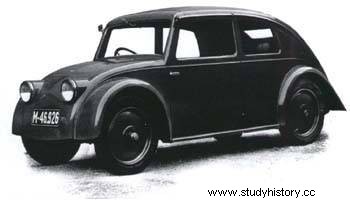Even people who are completely uninterested in the automotive industry know the longest and most produced car in history. The characteristic body of the Beetle evokes sympathy at first sight, but ... did its designer use his own idea?
In 1933, Adolf Hitler commissioned Ferdinand Porsche, known from his previous projects, to design a "Volkswagen", a car for the people. The guidelines were quite simple:the car was supposed to transport the family at a maximum speed of about 100 kilometers per hour and be cheap enough to be affordable for an average Reich citizen. The Sparkarte program was to help with that, thanks to which the purchase was very easy.
After a series of tests on Porsche prototypes, he was successful - probably one of the greatest in automotive history. As it soon turned out, however, the prestigious German National Award in the Field of Science and Art burdened the designer on his conscience. Why? The answer lay outside Germany, in Czechoslovakia…
Cheap and good
An affordable "car for the masses" was developed in Czechoslovakia from the early 1930s. A team of engineers led by Hans Ledwinka set the goal of creating a vehicle that was cheap to produce and easy to use, which could transport up to five people ... Sounds familiar? No wonder - and this is just the beginning of the similarities!
As a result, a prototype model Tatra V570 was created with a rounded shape of the hood, wheel arches and roof, with protruding round headlights. The car had an air-cooled two-cylinder boxer engine mounted at the rear. The project was distinguished, among other things, by an innovative technical solution allowing to redirect the cooling stream to the motor hidden behind the rear seat.

The final design of the Tatra V570
The V570 was followed by the mass-produced Tatry T77 and T97 models. One look at the body line is enough to bring the association:Beetle! The resemblance is striking - and it doesn't end in looks.
The "bowels" of nice cars were also very similar. Both the Tatra Mountains and the Beetles had engines with a parallel piston arrangement, mounted at the rear and air-cooled, which, among other things, allowed them to be used more freely at low temperatures. It's just that… Volkswagen prototypes were tested in 1935–39, while the Tatra Mountains T77 and T97 were ready in 1934!
Effective problem resolution
Hitler had little influence on the final car design. His initial objections to the rear-mounted engine left no trace on the final product, and the silhouette of the prototype was unlike a sketch possibly made by a dictator during his meeting with Porsch in March 1934, ”reads Bernhard Reiger's book The People's Car. And Gautam Sen in Million Cars for Billion People adds:
It turns out that Ledwinka discussed his ideas with Porsch, who used many Tatra design solutions at Kdf-Wagen . This is particularly evident when it is compared [Porsche design] to the smaller Tatra T97 with an air-cooled rear engine, flat piston layout and aerodynamic body style.
Meanwhile, despite the glaring evidence of automotive plagiarism, Porsche was awarded the German National Science and Arts Prize (the Nazi equivalent of the Nobel Prize) in 1937, which of course meant a large injection of cash for the designer ... whose conscience began to gnaw.

Porche TYPE 60, 1938
Ferdinand Porsche wanted to compensate his colleagues and provide them with compensation in cash, but Hitler arranged the problem for him - taking Czechoslovakia and annexing the Tatry plant to the Reich's estate. In this simple way, he ended the discussion about possible debts towards the injured Ledwinka and his engineers. The further fate of the heroes of this story is rather sad.
War as the engine of injustice
Porsche was arrested by the French as a war criminal in 1945. Later, when he was released, he was no longer welcome to his homeland. It was not even invited to the celebrations to mark the 50,000 and 100,000 units of the increasingly popular Volkswagen Beetle.
Ledwinka was also imprisoned on charges of collaborating with the Germans. He was released only in 1951, and completely rehabilitated posthumously - in the early 1990s.
Even before the start of World War II, Tatra was against VW for patent infringement, but the armed takeover of Czechoslovakia definitely cut short any discussions . On Hitler's orders, the production of Ledwinka cars was discontinued immediately after the Tatra factory was seized, and instead the focus was on heavy goods vehicles and diesel engines. The case ended only in 1961, when Volkswagen paid Tatra 3 million marks in compensation.
Bibliography:
- Reiger, B., The People's Car . Harvard University Press, Cambridge, 2013.
- Sen, G., Million Cars for Billion People . Platinum Press, Mumbai, 2014.
